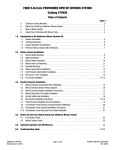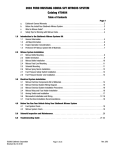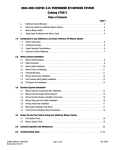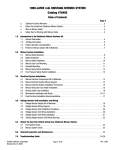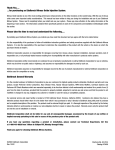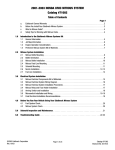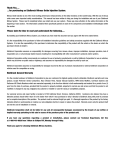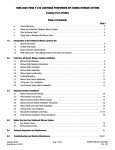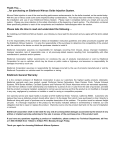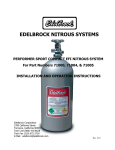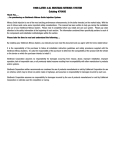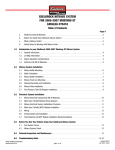Download Edelbrock 70402 Installation manual
Transcript
FORD 5.0L/4.6L PERFORMER RPM EFI NITROUS SYSTEM Catalog #70402 Thank You…. …for purchasing an Edelbrock Nitrous Oxide Injection System. Nitrous Oxide injection is one of the most exciting performance enhancements, for the dollar invested, on the market today. With the use of nitrous oxide come some important safety considerations. This manual has been written to help you during the installation and use of your Edelbrock Nitrous System. Please read it completely before you install and use your system. Please pay close attention to the safety information at the beginning of each section. The information contained there specifically pertains to each of the components and installation methodologies within the section. Please take the time to read and understand the following…. By installing your Edelbrock Nitrous System, you indicate you have read this document and you agree with the terms stated below: It is the responsibility of the purchaser to follow all installation instruction guidelines and safety procedures supplied with the Edelbrock Nitrous Systems. It is also the responsibility of the purchaser to determine the compatibility of the product with the vehicle or the device on which the purchaser intends to install it. Edelbrock Corporation assumes no responsibility for damages occurring from misuse, abuse, improper installation, improper operation, lack of responsible care, or all previously-stated reasons resulting from incompatibility with other manufacturer’s products and/or systems. Edelbrock Corporation neither recommends nor condones the use of products manufactured or sold by Edelbrock Corporation for use on vehicles, which may be driven on public roads or highways, and assumes no responsibility for damages incurred by such use. Edelbrock Corporation assumes no responsibility for damages incurred by the use of products manufactured or sold by Edelbrock Corporation on vehicles used for competition or racing. Caution!! Before You Install Your Edelbrock Nitrous System… Please read this Installation manual fully before installing this system. You will need to have available the following tools: Hand Tools: ❑ Socket set including ratchets and extensions ❑ Screwdrivers ❑ Pliers ❑ Bench vise ❑ Wire crimping pliers, wire strippers ❑ Floor jack ❑ Razor blade or other sharp, flat edged cutting instrument ❑ Vehicle jackstands ❑ Safety glasses Power Tools: ❑ Power drill ❑ Drill bits You should understand the following skills: ❑ Power tool safety procedures ❑ Undercar safety procedures ❑ Proper measuring techniques ❑ Proper electrical assembly techniques ❑ Basic engine operation and tuning techniques which include: -Fuel pressure measurement techniques -Timing adjustment techniques WHAT IS NITROUS OXIDE? Nitrous Oxide is a cryogenic gas composed of nitrogen and oxygen molecules. It is stored as a “gas over a liquid” which means that both liquid and gaseous nitrous oxide is delivered into your engine. It is 36% oxygen by weight, which is what produces the added horsepower. By injecting more oxygen (and a corresponding fuel signal), we create the additional power much like a supercharger or a turbocharger does. Nitrous Oxide is considered an “oxidizer” and not a fuel. Nitrous oxide is non-flammable by itself. Because nitrous oxide is a cryogenic, the same safety methods in handling dry ice apply to nitrous. Direct contact with the skin will cause a burn similar to contact with dry ice. The exception in using nitrous oxide comes from increased breathing hazards associated with the gaseous properties of nitrous oxide. Nitrous Oxide is offered for sale in two common grades, which are U.S.P., and Nytrous Plus. U.S.P. nitrous oxide is medical grade nitrous oxide. Its common use is dental and veterinary anesthesia as well as use as a propellant in food such as canned whip cream. U.S.P. is not available to the public and would provide no advantage in the making of horsepower over the automotive grade nitrous oxide. Nytrous Plus was specifically designed for automotive consumption and differs from U.S.P. in that it contains trace amounts of sulfur dioxide (100 parts per million or “PPM”) added to prevent substance abuse. The Sulfur Dioxide is an irritant to all of your breathing passageways and will cause sore throats and sore nasal passages. Nytrous Plus was specifically created for automotive applications and is available for sale to the public at many speed shops across the USA. Safety Steps For Working With Nitrous Oxide 1. Never inhale Nytrous Plus (Nitrous oxide (N2O) for vehicular use) as continued exposure can cause death. Nytrous Plus has a maximum of 100 parts per million (ppm) of sulfur dioxide and will cause irritation to nose and throat passageways. 2. When working around any high-pressure gas including nitrous oxide, take all precautions to ensure that exposure to nitrous oxide is minimized. 3. Do not vent nitrous oxide to atmosphere in confined spaces. Only vent nitrous oxide in well-ventilated and open areas. 4. Liquid nitrous oxide can cause burns to human flesh so protect all skin in and around your hands, arms and face. Wear safety glasses and rubber gloves to protect from liquid nitrous oxide splatter. 5. When venting down the nitrous system, vent the line down closest to the nitrous bottle. 6. Do not use any form of Teflon tape as sealant on fitting connections. Use only Teflon paste. 7. When washing components, ensure the clean components are completely dry, free of oils, and solvents. Failure to remove all liquids could cause component or system failure. 8. Always turn the bottle off before making any repairs to the nitrous delivery system. 9. To safely release nitrous oxide in a pressurized line; a. Position vehicle in a well-ventilated, unconfined space. b. Turn bottle off. c. Slowly loosen the nitrous feed line at the bottle until you hear a light hissing noise. d. Allow the entire nitrous pressure to vent from the line. e. Perform your work on the system. f. Tighten the nitrous line to the bottle. g. Slowly open the nitrous bottle valve, listening for leaks. h. Perform leak checks on all affected fittings and the bottle fitting. 1.0 Introduction to your Edelbrock 5.0L/4.6L Performer RPM EFI Nitrous System Within the pages of this manual is information, safety tips and operation instructions for your new Edelbrock Nitrous System. Watch for these symbols to know where to go for information. ….There is safety related information here. installation. ℡ ….call Edelbrock Technical support hotline for more information. ….shows where technical information about your vehicle or specific skills that may help during 1.1 General Information The Edelbrock 5.0L/4.6L Performer RPM EFI Nitrous System (Part Number 70402) is designed for 1986 through 1995 5.0L and 1996 through 1998 4.6L Ford Mustangs with return-style fuel systems and stock or slightly modified V8 engines. Horsepower and torque increases can vary with equipment upgrades and modifications. The system utilizes one nozzle that is installed in the intake boot just after the MAF (mass air sensor) filter and before the throttle body. The additional fuel needed is supplied by the vehicle’s standard fuel system. This system has been designed with some flexibility as to where certain components can be located to allow easy installation on vehicles with upgraded or modified equipment. The microswitch brackets are designed to be manipulated (bent, cut, twisted, etc.) and the electrical components have properly sized and ample lengths of wire. This system includes the bottle (shipped empty), bottle feed line and universal footprint steel bottle brackets. The mounting brackets also include rubber insulators to protect the surface of your nitrous bottle while mounted in the brackets. When installing your nitrous bottle, pay close attention to the installation instructions for the location of your bottle. Make sure that the installation of your bottle does not interfere with any systems that may lie under the location where you plan to drill holes for mounting the brackets. Contact your local automotive store, motorcycle shop or race track for refilling of your bottle. Trust a professional to properly fill your bottle and reference your installation manual when re-installing your filled bottle back into your vehicle. Always take care when handling a full bottle of nitrous oxide. Please reference this manual for further safety measures to take during the handling of a nitrous oxide bottle. Please follow all safety methods during the installation of your Edelbrock Nitrous System, and follow all vehicle regulations and road laws when using your nitrous system. 1.2 Jet Map Information Edelbrock Engineering has conducted dyno testing with the Edelbrock 5.0L/4.6L Performer RPM EFI system to ensure the horsepower increase with the nitrous system is as intended. On a typically stock 5.0L or 4.6L Mustang engine, you can expect the following approximate power gain: Nitrous Jetting .061 .067 Fuel Jetting .049 .047 Approx. HP Gains 125 150 Final Air/Fuel Ratio 13.5:1 13.5:1 The dyno tests were conducted at Edelbrock using stock 5.0L and 4.6L equipped cars. These tests were conducted with 950 psi nitrous bottle pressure. 1.3 Engine Operation Considerations When used correctly, nitrous oxide safely elevates cylinder pressures and temperatures while increasing combustion rate. These characteristics make the engine more sensitive to detonation. To ensure proper performance, engine and drive line life, the following tips are suggested: • System Jetting Never exceed the recommended jetting!! Excessive jetting will result in severe engine damage. • Fuel Quality Because Nitrous oxide is an oxidizer, fuel selection is critical. Both octane and fuel consistency affect fuel burn rate. The oxidizer quality of nitrous oxide will accelerate the burn rate, so we recommend a high quality of gasoline. We also recommend you use the same grade of gasoline every time you use your nitrous oxide system. This will help maintain the same fuel burn rate every time. • Ignition Components Most aftermarket performance chips increase the vehicle’s ignition timing, which can cause detonation with the use of nitrous oxide. Please consult with your chip manufacturer on information regarding the compatibility of your chip with nitrous oxide use. If your vehicle is equipped with platinum type spark plugs, we highly recommend they be removed and replaced with the equivalent standard type spark plug. • Engine System Upgrades With all performance modifications, complementary system upgrades will always serve to elevate the consistency and longevity of an engine, especially when using nitrous oxide as a power adder. Modifications such as ignition upgrades, free-flowing exhaust, camshafts, cylinder heads, manifolds can all add to the performance of a nitrous oxide injected engine. 1.4 Performer Nitrous System Bill of Materials Qty. Description 1 ea. 1 ea. 1 ea. Nozzle and Nozzle Hardware Nitrous fan spray nozzle Nitrous fan spray nozzle bulkhead body bolt Nitrous fan spray nozzle bulkhead concave nut 2 ea. 1 ea. 1 ea. 4 ea. 1 ea. 1 ea. 1 ea. 1 ea. 1 ea. Solenoids and Solenoid Hardware Performer nitrous solenoids Solenoid tee 1/8 NPT male x 1/8 NPT female x 1/8 NPT male EFI solenoid mounting bracket Solenoid mounting screws (8 x 32 UNC x 5/16”) 1/8 NPT Plug N2O Filter Fitting, 4AN x 1/8” NPT, Blue 3AN x 1/8” NPT Nitrous Fitting, Blue Microswitch mounting bracket 24” 3AN steel braided hose 90-degree on one end Jets 1 ea. Jet .047 1 ea Jet .049 1 ea Jet .061 1 ea Jet .067 Qty. Description 1 ea. 1 ea. 1 ea. 1 ea. Fuel Pressure Safety Switch and Hardware Fuel pressure safety switch 1/8 NPT female -4AN female swivel 1/16 NPT male x 1/8 NPT female 90 deg. 4AN female x 4AN male 1 ea. 1 pr. 1 ea. 1 ea. Bottle and Bottle Hardware 10-lb., Nitrous Bottle Nitrous Bottle Bracket Set (1 Tall, 1 Short) 660 Bottle Nut and Teflon Washer 14’ Nitrous Feed Line, Bottle to Solenoid 2 ea. 1 ea. Electrical System Components Electrical Component Packages (see “Electrical System Installation” section) Voltage Booster Unit 2.0 Nitrous System Installation 2.1 Nitrous Bottle Installation The nitrous oxide storage cylinder is typically called a “nitrous bottle”. It is an aluminum cylinder, designed and manufactured to withstand very high pressures. The valve on top of the bottle is a high-flow design that allows easy opening and closing which controls the nitrous flow to the engine compartment. Accurate calibration of your nitrous system depends on the bottle remaining at a stable temperature. In vehicles (such as Corvettes) where the bottle must be mounted in an area subject to direct sunlight, it is suggested that the bottle be shielded with a bottle blanket. If the bottle is mounted inside the passenger compartment or in a space that has access to the passenger compartment such as hatchbacks or vehicles that feature fold down rear seats, the pressure relief device (PRD valve) must be vented externally from the cockpit. This procedure will prevent the passenger compartment from filling with a cloud of nitrous oxide, should the safety pressure relief valve rupture. For more information, please contact the tech line. Special consideration should be made to protect the bottle installation by not placing the bottle in a known crumple or crash zone within the vehicle. At no time should the bottle be mounted within the seating area of the passenger compartment of a street-driven vehicle. Performer Bottle Valve Pressure Relief Device (PRD) 660 High Flow Nitrous Exit Here is the Performer Bottle Valve. Installed on all bottle valves used in Edelbrock Nitrous Systems, is a Pressure Relief Device or “PRD”. It is a safety valve designed to vent the contents of the bottle into the atmosphere in case of a catastrophic event like a collision. It is also installed to prevent the over-pressurization of the bottle. Unsafe bottle pressure is caused by over filling or elevated bottle temperatures. There are two types of PRDs - Internal piping and external piping. The internal type requires no additional parts. The external type requires a safety blowdown tube designed to route the gas, if the PRD happens to rupture, to the outside of vehicle. The internal type is design to vent directly off the bottle into the atmosphere. It is illegal to tamper with or remove this device. Bottle Safety Information 1. Do not attempt to remove the bottle valve. Please return your bottle to Edelbrock if service is required to the siphon tube inside the bottle or the bottle valve itself. 2. Never heat the outside of your nitrous bottle with an open flame like that of a torch. 3. Do not strike the surface of your nitrous bottle with a heavy or sharp object. 4. Do not drop your nitrous bottle. 5. Do not attempt to grind off or destroy any imprinted markings on the face of the bottle. 6. Do not remove, modify or otherwise tamper with the safety valve on the bottle valve. 7. Do not attempt to use a bottle that has been damaged or tampered with. Racing Vehicles Before you mount a nitrous bottle in a vehicle intended for use in racing or sanctioned events, check with the sanctioning association or local racetrack for any rules regarding bottle installation. Most associations require the bottle be mounted within the confines of the safety roll cage, with the safety pressure relief cap vented away from the driver’s compartment. 2.2 Bottle Orientation Accurate calibration of your nitrous system depends on the bottle remaining at a stable temperature. Choosing the proper location and orientation for your bottle can greatly affect the overall operation of the nitrous system. Please read the entire bottle mounting instruction section before making your final bottle location decisions. Bottle placement is critical to the performance of your nitrous system. It is important to understand how the bottle valve and siphon tube are assembled to properly orient the bottle in your vehicle and ensure that it picks up liquid nitrous while undergoing acceleration. All nitrous bottles are assembled so that the bottom of the siphon tube is at the bottom of the bottle, opposite the bottle label. An Edelbrock nitrous bottle cannot be mounted upside-down. Edelbrock does not offer a non-siphon tube bottle for automotive use. If the bottle must be mounted parallel to the axles of the vehicle (sideways), the label must be angled at approximately 45 degrees toward the front of the vehicle. This orientation will position the siphon tube toward the rear and pointing to the lower rear-facing quadrant of the bottle. All of this positioning information is critical to system operation. It is most important to draw as much liquid nitrous as possible. The siphon tube cannot do this unless the bottle is positioned correctly. The most efficient mounting is the lay-down position with the valve handle toward the front of the vehicle. This position allows the greatest amount of liquid to be used before the siphon tube begins to pick up gaseous nitrous oxide. 2.3 Nitrous Bottle Installation After you have determined the location and orientation of the nitrous bottle, use the following procedure to install the bottle: 2.3.1 Street Car Installations 1. Disconnect vehicle’s battery. 2. Determine the location of the bottle within the confines of the rear of the vehicle. 3. Once a mounting location has been determined, raise the vehicle (following all safety practices involved in working on a vehicle from under the vehicle) and verify that there are no fuel lines, fuel tank(s), brake lines, emissions equipment, or structural members in the way of potential mounting bolt locations. Note: It may be necessary to remove the fuel tank depending on the location where you install the bottle. 4. Install the rubber insulators within the bottle brackets. 5. Slip bottle into the mounting brackets. 6. Using the mounting bracket bolt holes as templates, mark an area for each of the brackets with chalk, metal marking pen, scribe, or marking pen to locate the bolt placements for drilling. 7. Drill two (2) 3/8” mounting holes for each bracket. 8. If heater blanket is used, brackets must be installed 8-1/2 inches apart from each other. 9. Install the bottle mounting brackets using “Grade 8” bolts, nuts and flat washers (not included with kit). Use fender washer underneath the vehicle for sheet metal mounting. 10. Tighten the mounting bolts using a thread locking compound (not included with kit). 11. Mock up Safety Blowdown tube on bottle to find where tube will go through floor. 12. Mark floor where tube appears it will go. 13. Using a 1/2” drill bit, drill through floor on mark. 14. Install Safety tube on bottle and cut off excess tube so that only 1 to 2 inches are protruding below floor. Shown here is a bottle with a bottle bracket properly installed with the rubber insulator. The distance between the bottle brackets is somewhat adjustable. Remember, mount the short bottle bracket at least 1” from the bottom of the bottle, and never cover any of the bottle label with a bottle bracket. Do not attempt to install the bottle in the bracket without the rubber insulator. The bottle hoop on the bracket is designed to include the thickness of the insulator. 2.3.2 Race Car Nitrous Bottle Installations Install the bottle brackets in accordance to race track and/or sanctioning body rules. Contact the factory for assistance with meeting sanctioning body rules. 2.3.3 Nitrous Bottle Installations For Vehicles With Hatchbacks Or Trunk Areas That Are Connected With The Passenger Compartment. 2.4 Nitrous Feed Line Mounting 1. Determine the route your main nitrous feed line will follow. Ensure the path does not route the nitrous feed line too close to the exhaust system, suspension, electrical lines/components or tires. 2. Attach nitrous supply line to bottle. 3. Feed nitrous line along proposed route. 4. Secure nitrous supply line to underside of vehicle. Note: Stainless steel covering of the main nitrous feed line is very abrasive. Shield painted components or sensitive system components like electrical, fuel lines, brake lines or suspension components to prevent them from contacting main feed line. Rubber hose can be slid over and retained as a chafe guard. 5. Leave nitrous line loose pending installation of nitrous solenoid. 2.5 Solenoid Mounting Use the following procedures to install the Performer nitrous solenoids. Note: Remember to use Teflon paste only on pipe threads. Do not use Teflon tape. Hint: Placement of the solenoid is often limited by the lack of possible mounting locations in the engine compartment. However, if possible, observe the following suggestions: Solenoid Safety Information 1. Keep solenoids and lines away from exhaust components. 2. Trial fit the solenoids with all lines attached to ensure a proper fit. 3. Solenoids may be mounted sideways or upside-down, if necessary. 2.5.1 Nitrous Solenoids Mounting 1. Locate the EFI solenoid bracket, solenoids, inlet fitting, outlet fitting, plug, solenoid tee, and solenoid mounting screws. 2. Hold one of the nitrous solenoids securely (like in a bench vise) being careful not to harm the solenoid or block the inlet or outlet port of the solenoid. 3. Install the nitrous filter fitting (Blue fitting 4AN X 1/8 NPT), using liquid Teflon paste, in the inlet port of the nitrous solenoid. 4. Install one of the 1/8 NPT male sides of the solenoid tee, using liquid Teflon, on the outlet port of the nitrous solenoid. The female port of the solenoid tee should be facing outward. 5. Install the remaining 1/8 NPT male end of the solenoid tee, using liquid Teflon, into the inlet port of the second nitrous solenoid. Rotate the second solenoid so that it parallels the first. 6. Install the 3AN X 1/8 NPT (blue straight fitting) into the outlet port of the second nitrous solenoid. 7. Install one end of the 1/8”NPT male x 1/8”NPT male nipple fitting, using liquid Teflon paste, into the nitrous pressure regulator inlet port which is the port on the end. 8. Loosely thread the nitrous pressure regulator/nipple assembly into the 1/8”NPT female port on the solenoid “Tee”. 9. Using liquid Teflon paste, install the 1/8”NPT x 3/16” barb fitting into the side of the nitrous pressure regulator. 10. Remove the assembly from the vise and mount the solenoid bracket to the solenoids. 11. Install the solenoid/regulator assembly in your desired location. Tighten the nitrous regulator until the barb fitting points towards the vehicle’s fuel pressure regulator. 12. Leave all wiring loose for electrical systems installation. 13. Connect the main nitrous feed line to the inlet fitting (4AN X 1/8 NPT nitrous filter fitting) of the first nitrous solenoid. Shown above is a typical EFI solenoid assembly using an unmodified EFI solenoid bracket as well as an exploded view of the nitrous solenoid assembly. Modifications performed to a solenoid bracket depend on many factors. When mounting the solenoid assembly on a vehicle, considerations should be taken regarding any potential interference with the vehicle’s systems or components. The line length between the Performer RPM EFI solenoid assembly and the jet fitting on the nitrous spray nozzle is 24 inches. This should also be considered when mounting the solenoid assembly. 2.6 Nitrous Spray Nozzle Installation 1. Determine nozzle mounting location in intake boot, between the MAF sensor and the throttle body. Make sure the nozzle, mounting collar, and the feed line from solenoid to nozzle, do not interfere with any systems or components of the vehicle such as the hood latching device. Nozzle 2. Mark where the nozzle will be placed. 3. Remove the intake boot. 4. Drill a 7/16” hole in the intake boot where nozzle placement was determined. 5. Be sure to clean out the rubber shavings you made when drilling to prevent engine damage. 6. Install nozzle mounting nut and collar onto intake To Throttle Body boot. 7. Using liquid Teflon, install the spray nozzle into From Airbox mounting collar. 8. Mark the spray direction on the nozzle. Be sure the Nozzle should be placed in the intake boot so as to have a clear path to the throttle body. Try to nozzle discharge is towards the vehicle’s engine. keep the nozzle from having to travel through the 9. Install the .039 jet into the nozzle fitting. 10. Install 3AN line from solenoid outlet fitting to spray bend in the intake boot and as close to the throttle body as possible. nozzle jet fitting and tighten securely. 11. Install the intake boot. 2.7 Fuel Pressure Safety Switch Installation 1. Locate the fuel rail test port fitting. 2. Make sure the vehicle’s engine is cool. Release pressure in the fuel system by pressing down on the valve in the center of the fitting. Cover top fitting with a rag whicle releasing pressure. This will allow the pressure to escape as well as some fuel. 3. After relieving all pressure, remove test port fitting core and install the 1/16 NPT male X 1/8 NPT female brass fitting in its place, using liquid teflon paste. 4. Using liquid Teflon paste, install Fuel Pressure Safety Switch into the 1/8 NPT female adapter end. Note: On some vehicles, there is no test port fitting, or the location of the test port fitting does not allow ample room for the fuel pressure safety switch to be mounted. These applications will require a “Banjo Nut” at the fuel filter to be drilled and tapped to allow mounting of the safety switch. 2.8 EFI Vacuum “Tee” Installation 1. Refer to the jet map and select the correct fuel jet for your horsepower setting. Install the jet into the EFI vacuum tee, between the tee and the blue anodized fitting. Tighten fitting securely. 2. Remove the vacuum line from the vehicle’s fuel pressure regulator. 3. Install the vacuum line that originally went to the vehicle’s fuel pressure regulator onto the center barb fitting of the EFI vacuum tee. Note: The center barb can easily be identified by the anodized nut used to hold the Pressure Relief Jet. 4. Measure the correct length of vacuum line from the barb on the Fuel Pressure Regulator to one port of the EFI Vacuum Tee. Cut the vacuum line and install. 5. Measure the correct length of vacuum line from the barb fitting of the nitrous pressure regulator to the remaining open port on the EFI Vacuum Tee. Cut the vacuum line and install. 6. Using the included hose clamps, secure all hose connections on the tee and regulators. 2.9 Fuel Pump Installation Warning: Before performing any of these steps, relieve the pressure in the fuel system. 1. Locate the fuel filter on the under-carriage of the car. Disconnect the hard fuel line from the filter. 2. Install the fuel pump fittings into the fuel pump and find a secure and safe area to mount the fuel pump under the vehicle within reach of the fuel filter. 3. Measure and cut a length of the supplied fuel hose from the outlet of the fuel filter to the inlet of the fuel pump. Connect one end of the cut fuel hose to the barb fitting on the inlet side of the fuel pump and secure with one of the supplied hose clamps. 4. Install the female Ford Fuel Hose Connector into the remaining end of the fuel hose and secure with one of the supplied hose clamps. Connect the Ford Fuel Hose Connector to the outlet of the fuel filter. 2.9 Fuel Pump Installation (Continuation) 5. Measure and cut a length of the supplied fuel hose from the outlet of the fuel pump to the fuel hose that runs towards the engine compartment. Connect one end of the cut fuel hose to the barb fitting on the outlet side of the fuel pump and secure with one of the supplied hose clamps. 6. Install the male Ford Fuel Hose Adapter into the remaining end of the fuel hose and secure with one of the supplied hose clamps. Connect the male Ford Fuel Hose Adapter into the female Ford Fuel Hose Connector and secure with the supplied replacement Ford Clip as shown in the illustration below. 7. Turn the ignition to the “on” position without starting the vehicle and check the fuel fittings and hoses for leaks. Double check to make sure that everything is securely mounted and away from moving components or sources of heat. 3.0 Electrical System Installation 6 7 1 4 5 3 11 9 8 14 10 12 13 3.1 15 Nitrous Electrical Components Bill of Materials (BOM) Item # Quantity Description 1 1 ea. Activation microswitch 2 1 ea. Activation microswitch bracket (not shown) 3 2 ea. Activation microswitch mounting nut 4 2 ea. Activation microswitch mounting screw 5 1 ea. 30 amp relay 6 1 ea. Wire harness with integral relay/fuse holder 7 1 ea. Red lighted toggle switch 8 2 ea. 18/22g female spade connector, Nylon insulated 9 2 ea. 14/16g female spade connector, Nylon insulated 10 1 ea. 14-16g male spade connector, Nylon insulated 11 1 ea. 16/18, splice connector 12 1 ea. 14/16g 3/8” ring terminal, Nylon insulated 13 3 ea. 18/22g ring terminal #10 Stud, Nylon insulated 14 2 ea. 18/22g ring terminal #8 Stud, Nylon insulated (.187) 15 2 ea. 18/22g female spade connector, Nylon insulated 16 1 ea. 15 amp ATO blade fuse Nomenclature Descriptions: ATO… the fuse configuration is ATO. When replacing this fuse, ask for an ATO fuse. “a”… Amperage. Important: The wiring hardware and instructions included with this kit are intended for 12-volt electrical systems only. Before attempting to wire your Edelbrock Performer nitrous oxide system, examine and follow the wiring diagram on the following page. Please call the Edelbrock Technical department with any questions concerning electrical wiring. When working with electrical systems in your vehicle, it is a good idea to have a service manual that features your vehicle. It is also good practice to have a book that specializes on the specialized techniques required when working with vehicular electrical systems. 3.2 Nitrous Electrical System Wiring Diagram 3.3 Nitrous Electrical System Installation Procedures Determine the location of the relay and fuse holder wire harness. Most common installations locate these components inside the driver’s compartment and close to the fuse panel under the dash. You can also mount the relay and fuse holder harness close to the battery. However, these connectors are water-resistant not waterproof, so care is required when mounting this assembly under the hood of your vehicle. Wire Schematic Origin and Destination Map Wire Color Red Red Blue White Black Black Black Black Black Black 3.4 System Main System Bat. Voltage Arming Switch Solenoid Power Solenoid Power Relay Power Arming Switch Ground Relay Ground Microswitch Ground Solenoid #1 Ground Solenoid #2 Ground Safety Switch Fuel Pressure Safety Switch Ground Origin Relay Harness Destination Bat. Volt. Signal Terminal Used Ring Arming Switch Switched 12V Relay Harness Relay Harness Arming Switch Relay Harness Microswitch Solenoid #1 Solenoid #2 Solenoids #1 & #2 Arming Switch Chassis Ground Microswitch Chassis Ground Chassis Ground Fuel Pressure Spade/Wire Intercept Spade Spade Spade/Ring Spade Spade/Ring Ring Ring Fuel Pressure Safety Switch Chassis Ground Ring/Ring Nitrous Relay and Fuse Holder Installation The wire harness attached to the relay and fuse holder includes 8 feet of color-coded wires to make the electrical system installation for your Edelbrock Nitrous System as easy as possible. We recommend that you do not cut any lengths of wires from the wire harness or complete the wiring of the nitrous system until all of the mechanical components are securely mounted in their permanent locations. Once all of the solenoids and switches are placed, then route the un-cut wires from the harness to each location allowing enough wire length on each circuit to not interfere with operating linkages, heat sources, brackets, etc. Pay particular attention to sharp edges along the route of your wire harness as they can chafe the wire and cause your system to fail. After you have accounted for the routing of your wires, follow the Wire Harness Schematic on page 16 and use the Origin and Destination Map as a guide for which electrical connectors are used in each circuit. Once you have decided the location of the relay and fuse holder, secure them with fasteners (not included with kit) such as sheet metal screws, bolts and nuts, etc. Allow for some slack in the red wire that connects the relay and fuse holders together. When mounting your relay and fuse holder, make sure the mounting surface is strong enough to support servicing the relay and fuse. Also, ensure you allow for some slack in the wire that joins the fuse holder to the relay mount. This will avoid any potential loss of power due to stress on the wire harness. The fuse is covered by the fuse mount housing. The relay for the Performer system is rated for 30 amps, and the fuse is 15 amps. 3.5 Arming Switch and Installation The arming switch is a red, lighted switch that is a “MASTER” arming switch for your nitrous system. Without it, your nitrous system would be “on” all of the time and capable of engaging anytime you go to wide-open throttle conditions with your vehicle. The switch, when in the “armed” position, is well lit. Therefore, it should be placed in an obvious position well within the line of sight and easy reach of the driver. Please refer to the procedures below for the installation of the arming switch: 1. 2. 3. 4. Locate the final position of your arming switch. Drill a .450” (approx. 29/64”) hole for the switch location. Insert the switch from behind the mounting hole and secure with the switch nut. Do not wire until all other mechanical components are in place. Please see the electrical system installation instructions for further information. Note: There is a collar included with the switch for applications that require special spacing during installation. 3.6 Microswitch Installation and Wiring The function of your microswitch is to enable your nitrous system. It should be installed so that the switch is forced closed by coming in contact with the throttle linkage only at the wide open throttle position. The nitrous system must only function at fully-loaded wide-open throttle. MICROSWITCH SAFETY INFORMATION 1. Do not allow wiring from the microswitch to come in contact with heat sources on the intake manifold such as EGR risers or passageways. 2. Do not run wires to the microswitch that can create interference with the operation of the throttle linkage. 3. The microswitch must be located in such a way as to be clear of the normal operation of the throttle linkage. 4. Do not directly expose the microswitch to liquids such as water or gasoline. This is a picture of an un-modified and “ready to install” microswitch assembly. The microswitch bracket has several mounting positions available for clocking of the switch. It also is of a universal length and can be attached to several positions on and around the throttle body. 3.6 Microswitch Installation and Wiring (continuation)... The bolts used to attach the microswitch have extra length to allow for spacing the microswitch away from the bracket to offer a level of adjustability of the microswitch. After determining the position of the microswitch, we recommend trimming the bolts for a clean installation. Due to the wide variety of throttle linkage combinations in use, it is impossible to supply a microswitch bracket custom-tailored to each application. The universal bracket supplied will need to be modified to fit your specific application. Here is a microswitch assembly mounted for use. It is an example of one of many ways in which to mount a microswitch on your throttle body. The microswitch bracket allows for many different mounting positions. The microswitch bracket can be modified to clear almost any potential interference around the throttle linkage. The microswitch bracket supplied is drilled to permit many different switch mounting positions. This flexibility allows for the microswitch to be positioned in such a manner to engage the throttle body linkage without interfering with its normal and safe operation. The bracket may be manipulated (bent, twisted, and/or cut) to best suit your combination. Mount the microswitch on the throttle body so the actuation arm is triggered by the throttle linkage making sure that all wiring and the bracket do not interfere with the smooth and safe operation of the throttle body. Be sure the actuation arm “clicks” at the point where the throttle is wide open. 3.7 Final Electrical Installation Recommendations At this time, it is advised that you double-check the following areas: 1. Double Check all wires so that they do not come in contact with any heat sources like exhaust manifolds, and EGR crossovers, etc. 2. Double Check the wires that lead from the microswitch to ensure that they do not interfere with the operation of the throttle body linkage. You are now ready to hook up your battery and prepare your vehicle to run. 3.8 Fuel Booster Pump Electrical Components Bill of Materials (BOM) Item # 1 2 3 4 5 6 Quantity 1 ea. 1 ea. 1 ea. 3 ea. 2 ea. 1 ea. Description 30 amp relay Wire harness with integral relay/fuse holder 16/18, splice connector 14/16g 3/8” ring terminal, Nylon insulated 14/16g ring terminal #8 Stud, Nylon insulated 15 amp ATO blade fuse Fuel Pump Relay Wiring Schematic 4 RED Relay 1 Fuel Pump Wire 2 Socket 3 WHITE BLUE 5 Battery BLACK 5 4 Fuel Pump Item 1 2 3 4 5 Qty. 1 1 1 3 2 4 Description 30 amp Relay Wire Harness 16/18 Splice Connector 14/16G 3/8” Ring Terminal, Nylon Ins. 14/16G Ring Terminal #8 Stud, Nylon Ins. 3.9 Fuel Booster Pump Electrical System Installation Procedures Determine the location of the Fuel Booster Relay and Fuse Holder wire harness. Most common installations locate these components inside the driver’s compartment and close to the fuse panel under the dash. You can also mount the relay and fuse holder and harness close to the battery or in the trunk compartment. However, these connectors are water-resistant, not water-proof, so care is required when mounting this assembly under the hood of your vehicle. Wire Schematic Origin and Destination Map Wire Color Red System Origin Destination Terminal Used Main Booster Relay Harmess Bat. Volt. Signal 3/8” Ring Pump Bat. Voltage 3.10 Blue Fuel Pump Power Relay Harness Fuel Booster Pump #8 Ring Black Fuel Pump Ground Fuel Booster Pump Chassis Ground #8 Ring / 3/8” Ring White Relay Power Relay Harness Fuel Pump Wire Splice Conn. Black Relay Ground Relay Harness Chassis Ground 3/8” Ring Fuel Booster Pump Relay and Fuse Holder Installation The wire harness attached to the relay and fuse holder includes 8 feet of color-coded wires to make the electrical system installation for you Edelbrock Nitrous System as easy as possible. We recommend that you do not cut any lengths of wires from the wire harness or complete the wiring of the nitrous system until all of the mechanical components are securely mounted in their permanent locations. Use the wiring schematic on the previous page along with the Origin and Destination Map above to determine the proper routing for the wires and their locations. Take caution as to not interfere with operating linkages, heat sources, brackets, etc. Pay particular attention to sharp edges along the route of your wire harness as they can chafe the wire and cause your system to fail. Locate the fuel pump wires, which are located just above the fuel tank, feeding in towards the in-tank pump. Locate the wire that should be spliced into for the white trigger wire on the fuel booster pump relay. You will need to splice the white wire in line with the correct wire leading towards the fuel pump. For model years 1998-1993, the correct wire is pink and blank. For model year 1994-1998, the correct wire is brown and pink. Use the supplied wire splice to intersect this wire. Once all components have been securely mounted decide the location of the relay and fuse holder. Secure them with fasteners (not included with kit) such as sheet metal screws, bolts and nuts, etc. Allow for some slack in the red wire that connects the relay and fuse holder together. When mounting your relay and fuse holder, make sure the mounting surface is strong enough to support servicing the relay and fuse. Also, ensure you allow for some slack in the wire that joins the fuse holder to the relay mount. This will avoid any potential loss of power due to stress on the wire harness. Be sure to cover the fuse with the fuse mount housing. 4.0 Before You Run Your Vehicle Using Your Edelbrock Nitrous System You have just completed the installation of your Edelbrock Nitrous System. It is time to perform some basic system checks to ensure all of the work you have done is correct and ready to operate properly. The following procedure is designed to validate the operation of your nitrous system before operating your vehicle: Note: Before performing steps 1 through 4, make sure that the nitrous bottle is closed and main nitrous supply line is empty of any nitrous. 4.1 Fuel System Check 1. 2. 3. 4. 4.2 Nitrous System Check 1. 2. 3. 4. 5.0 Hook up all battery leads. Double-check all wires and leads for signs of heat and proper connections. Turn the ignition key to the “on” position without starting the engine. Inspect the fuel rail where the Fuel Pressure Safety Switch has been installed for any leaks. Also check the booster fuel pump and coresponding fuel lines on the undercarriage of the vehicle for leaks. With the vehicle's engine running, slowly open nitrous bottle valve. Note: There should be no change in engine idle speed. If idle speed changes, close nitrous bottle valve immediately and refer to the "Troubleshooting Guide" section. Inspect nitrous lines and fittings for leaks using a soapy water mixture and a small brush. If any of the fittings/connections show bubbling around the attachment nut or on the threaded area of the fitting, shut the nitrous bottle valve off immediately and dry the fitting before attempting any service to that particular fitting connection. If the engine idle does not come up, and all of the fittings appear to be leak-free, you have successfully completed the installation of you Edelbrock Nitrous System. Solenoid Inspection and Maintenance 1. Close the valve on the nitrous bottle. Make sure all nitrous supply lines are free of pressure before removal of any system solenoid. a. Empty main nitrous supply line at the nitrous bottle. Take care to not breathe or expose your skin to nitrous. b. Do not open pressurized fuel lines over a hot engine. 2. Remove nitrous solenoid from the engine and securely clamp it into a vise, taking great care not to damage the solenoid. Remove the solenoid cover, retaining nut from top of the nitrous solenoid and remove the coil and housing from nitrous solenoid base. 4. Unscrew stem from nitrous solenoid base. Do this by using a solenoid stem removal tool or by “double nutting” the stem and unscrewing the stem from the housing body. Do not use pliers on solenoid stem; damage to the stem will result. 5. Carefully remove the stem, spring and plunger from the solenoid base paying close attention to the way they are assembled. 6. Examine the plunger seal for swelling, cuts and abrasions. The seal surface should be flat, except for a small circular indentation in the center of the seal. A seal that has been contaminated or over-pressurized will bulge from exposure to chemicals other than nitrous oxide. It can appear to extend down from the plunger and be dome-shaped. A contaminated seal may return to its original shape if left out in fresh air for approximately 48 hours. It may then be returned to service. If it does not return to its original shape, it must be replaced. 7. Clean the solenoid body. Do not use an oil-based solvent to clean any part of the solenoid. Use paint thinner or electrical contact cleaner. Remove any contaminants that may be present. Make sure solenoid body is clean, dry and free of oils before assembly. 8. Replace the O-Ring, plunger and piston spring and then re-assemble solenoid by reversing disassembly procedure. 6.0 Troubleshooting Your Edelbrock Nitrous System How to use our Troubleshooting Flowchart: The troubleshooting of a nitrous system is basic and straightforward. The symptom chart is divided by symptom, cause and action required. Determine your problem (symptom), identify the potential problem (cause) and correct the problem (action required). Symptom #1… There is No change in engine speed when system is activated. 1. System wired incorrectly. a. Compare wiring to schematic. i. Wire per instructions. See “Nitrous Electrical System Wiring Diagram” section. 2. Restricted fuel line. a. Inspect fuel line for restrictions. i. Remove restrictions (kinks in rubber line, pieces of rubber hanging in flow path, etc.). b. Check Fuel Pressure. i. Increase fuel delivery as needed. Symptom #2… Change in engine speed when nitrous bottle valve is opened. 1. Malfunctioning nitrous solenoid. a. Repair/replace solenoid. See “Solenoid Inspection and Maintenance” section. 2. Contamination in nitrous solenoid. a. Remove and inspect solenoid for dirt around seat area of plunger in solenoid. Symptom #3… Engine runs excessively rich when system is activated. 1. Nitrous bottle valve not fully opened. a. Check bottle valve. i. Open valve fully. 2. Nitrous bottle mounted improperly. a. Mount bottle properly. See “Nitrous Bottle Installation” section. 3. Plugged nitrous filter. a. Clean and/or replace nitrous filter. b. See nitrous solenoid symptom #2. 4. Low bottle pressure. a. Weigh bottle. i. Bottle should be 10 lbs. above empty bottle weight listed on bottle label when full. b. Check bottle temperature. i. Maintain 80 to 85 degrees of bottle surface temperature. Symptom #4… High RPM misfire when system is activated. 1. Excessive spark plug gap. a. Inspect spark plugs. i. Set plug gap at 0.030 – 0.035 inch. ii. Contact the manufacturer of your plugs for more information. 2. Weak ignition/ignition component failure. a. Inspect ignition components. i. Replace worn components. ii. Upgrade ignition system to high performance high load capable ignition components. Symptom #5… No change in performance when system is activated. 1. System wired incorrectly. a. Compare wiring to schematic. i. Wire per instructions. 2. Loose ground wires. a. Connect test light to battery “+” (positive) terminal. Check for continuity at grounds. i. Tighten/repair loose grounds. 3. No power to arming switch. a. With ignition on, connect test light to battery “–” (negative) terminal. Check for power at pole #1 on arming switch. i. Repair wiring. 4. Malfunctioning arming switch. a. With ignition on, turn arming switch on. Connect test light to battery “–” (negative) terminal. Check for power at red wire on arming switch. i. Replace arming switch. 5. Malfunctioning microswitch. a. Turn arming toggle off. Close throttle microswitch, check for continuity between microswitch wiring terminals. i. Replace microswitch. 6. Inadequate nitrous supply. a. Weigh bottle. i. Bottle should be 10 lbs. above empty bottle weight listed on bottle label when full. b. Check bottle temperature. i. Maintain 80 to 85 degrees of bottle surface temperature. c. Check bottle valve. i. Open valve fully. d. Check bottle orientation. i. Mount bottle properly. 7. Mismatched nitrous/fuel jetting a. Compare jetting to recommended values. i. Install correct jets b. Verify the number stamped in the jet match the desired power level. i. Acquire the right size jets and install correct jets. 8. Excessive fuel pressure. a. Perform Fuel Pressure Test Procedure. b. Install fuel pressure gauge. i. Regulate pressure to proper settings. 9. Loose nitrous solenoid wiring. a. Inspect solenoid wiring. See “Electrical System Installation” section. b. Consult a book concerning proper wiring methods. 10. Malfunctioning nitrous solenoid. a. Inspect solenoid wiring. See “Electrical System Installation” section. i. Repair wiring. b. Inspect solenoid. See symptom #2. i. Rebuild/replace solenoid. Symptom #6… Engine detonates mildly when system is activated. 1. Inadequate octane fuel. a. Verify what gasoline you use. i. Use higher-octane fuel. 2. Spark plug heat range too high. a. Verify what heat range the spark plug is, and how it functions in a high load, high performance application. i. Install a performance spark plug. ii. Reduce spark plug heat range. 3. Too much nitrous flow. a. Verify the size of the nitrous jet. i. Install the proper nitrous jet. b. Check bottle temperature and pressure. i. Ensure before every nitrous usage that you only use nitrous when the temperature and pressure of your bottle are correct. Symptom #7… Engine detonates heavily when system is activated. Inadequate fuel delivery due to: 1. Plugged fuel filter. a. Inspect fuel filter. i. Clean or replace filter. 2. Crimped fuel line. a. Inspect fuel line. i. Replace crimped line. 3. Weak or inadequate fuel pump. a. Install fuel pressure gauge. Run engine under load at wide-open throttle, with system activated. i. Repair or replace fuel pump. ii. Install nitrous dedicated fuel supply. 4. Improper fuel booster pump installation. a. Check inlet and outlet sides of the booster pump. i. Be sure outlet is flowing towards the engine. ii. Check to be sure inlet is feeding from the fuel filter and tank. Symptom #8… Vehicle surges under acceleration when system is activated. 1. Inadequate nitrous supply. a. Weigh bottle. i. Bottle should be 10 lbs. above empty bottle weight listed on bottle label when full. b. Check bottle temperature. i. Maintain 80 to 85 degrees of bottle surface temperature. c. Check bottle valve. i. Open valve fully d. Check bottle orientation. i. Mount bottle properly. EDELBROCK FUEL SYSTEMS
























